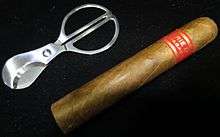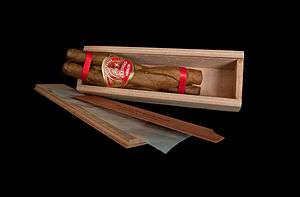Partagás (cigar brand)

Partagás is among the oldest extant brands of cigars, established in Havana in 1845. The name is used today by two independent and competing entities, one produced on the island of Cuba for Habanos SA, the Cuban state-owned tobacco company; the other, containing no Cuban tobacco, produced in the Dominican Republic for General Cigar Company, a division of Scandinavian Tobacco Group of Denmark.
Cuban Partagás
History

The Catalan Don Jaime Partagás y Ravelo (Arenys de Mar, 1816 - Vuelta abajo, Cuba, 1868) was the son of Jaume Partagás (tailor) and Teresa Ravelo. He migrated to Cuba in 1831 and worked for Lloret de Mar businessman, Joan Conill in Havana. Establishing his own factory, La Flor de Tabacas de Partagás in 1845, at 1 Cristina St.[1] in Havana. Don Jaime owned many of the best plantations in the Vuelta Abajo tobacco-growing region of Cuba; being able to choose from among the finest tobaccos on the island made the brand incredibly successful. Don Jaime is also believed to have experimented with various methods of fermenting and aging tobacco and is legendarily credited with hiring one of the first lectors to read to and entertain the cigar rollers as they worked.
Don Jaime was murdered on one of his plantations in 1868[1] and his son José Partagás took over the business. Later the factory and brand were sold to banker José A. Bance, who in turn sold to Cifuentes, Fernández y Cía in 1900. In 1916, Don José Fernández apparently left the firm and Ramón Cifuentes Llano joined with Francisco Pego Pita to form Cifuentes, Pego y Cía. In 1927, it acquired the rights to the Ramón Allones brand; at some unknown point the factory began to produce a brand in its own name, Cifuentes.
Ramon Cifuentes died in 1938 and Pego in 1940, leaving the Cifuentes family solely in control of the increasingly prestigious factory and brand, which renamed the company Cifuentes y Cía. In 1954, the Cifuentes family acquired the Bolívar and La Gloria Cubana brands from José F. Rocha and moved their production to the Cifuentes factory. By 1958 it was second only to the H. Upmann company in exporting Cuban cigars, accounting for over a quarter of all exported tobacco goods.
Before and after the Cuban Revolution, the authentic Cuban-produced Partagás has been one of the most revered and highest-selling cigars in the world. By the middle 1990s it remained the second leading selling Cuban brand, following Montecristo, with annual sales of approximately 10 million cigars.[2]
The old Partagás Factory in Havana, since renamed "Francisco Pérez Germán", was responsible for the production of much of the brand until it was relocated 3km from Havana Vieja. The new factory now continues the tradition. Both locations are popular tourist destinations for cigar smokers vacationing in Cuba.[2] The move to the new factory took place on January 2, 2012.[1]
In 2002, Altadis bought a controlling share in the Cuban government-owned cigar distributor, Habanos SA, and instituted a number of changes in cigar production. Among them was gradually turning the various brands of Cuban cigars to either all-handmade or all-machine-made lines, reducing the number of redundant sizes within a brand, and eliminating many low-selling cigars. Partagás, which has historically produced a variety of handmade and machine-made or machine-finished cigars, had several of its vitolas cut from production, much to the dismay of connoisseurs worldwide.
Since the introduction of the Edición Limitada annual releases, Partagás has produced a special size almost every year: the Pirámide in 2000, the Serie D No. 3 in 2001, the Serie D No. 2 in 2003, the Serie D No. 1 in 2004, a reissue of the Serie D No. 3 in 2006, and the Serie D No. 5 in 2008. In 2005, Partagás introduced a pyramid, the Serie P No. 2, which has proven highly popular with cigar connoisseurs.
Partagás also offers two machine-made cigarillos (the Mini and the Club) and a brand of cigarettes.
Vitolas in the Partagás Line


The following list of vitolas de salida (commercial vitolas) within the Partagás marque lists their size and ring gauge in Imperial (and Metric), their vitolas de galera (factory vitolas), and their common name in American cigar slang.
Hand-Made Vitolas
- 898 Cabinet Selección Varnished - 6 3⁄4" × 43 (171 × 17.07 mm), Dalia, a lonsdale
- Aristocrat - 5 1⁄8" × 40 (130 × 15.88 mm), Petit Cetro, a petit corona
- Corona Junior - 4 5⁄8" × 40 (117 × 15.88 mm), Coronita, a petit corona
- Corona Senior - 5 1⁄4" × 42 (133 × 16.67 mm), Eminente, a corona
- Culebras - 5 3⁄4" × 39 (146 × 15.48 mm), Culebras, a culebra
- Habanero - 4 7⁄8" × 39 (124 × 15.48 mm), Belvedere, a short panetela
- Lusitania - 7 5⁄8" × 49 (194 × 19.45 mm), Prominente, a double corona
- Mille Fleurs - 5 1⁄8" × 42 (130 × 16.67 mm), Petit Corona, a petit corona
- No. 1 - 6 3⁄4" × 43 (171 × 17.07 mm), Dalia, a lonsdale
- Partagás de Luxe - 5 1⁄2" × 40 (140 × 15.88 mm), Crema, a corona
- Petit Corona Especial - 5 1⁄4" × 42 (133 × 16.67 mm), Eminente, a corona
- Presidente - 6 1⁄4" × 47 (159 × 18.65 mm), Taco, a perfecto
- Princess - 5" × 35 (127 × 13.89 mm), Conchita, a short panetela
- Serie du Connaisseur No. 1 - 7 1⁄2" × 38 (191 × 15.08 mm), Delicado, a long panetela
- Serie du Connaisseur No. 2 - 6 1⁄2" × 38 (165 × 15.08 mm), Parejo, a panetela
- Serie du Connaisseur No. 3 - 5 5⁄8" × 35 (143 × 13.89 mm), Carlota, a panetela
- Serie D No. 4 - 4 7⁄8" × 50 (124 × 19.84 mm), Robusto, a robusto
- Serie D No. 5 - 4 1⁄3" × 50 (110 × 19.84 mm), Serie D No. 5, a petit robusto
- Serie D No. 6 - 3 1⁄2" × 50 (90 × 19.84 mm), Serie D No. 6, a petit robusto
- Serie E No. 2 - 5.5" x 54 (140 x 54), Duke, a robusto extra
- Serie P No. 2 - 6 1⁄8" × 52 (156 × 20.64 mm), Pirámide, a pyramid
- Short - 4 3⁄8" × 42 (111 × 16.67 mm), Minuto, a petit corona
- Super Partagás - 5 1⁄2" × 40 (140 × 15.88 mm), Crema, a corona
Edición Limitada Releases
- Pirámide (2000) - 6 1⁄8" × 52 (156 × 20.64 mm), Pirámide, a pyramid
- Serie D No. 3 (2001/re-release in 2006), - 5 5⁄8" × 46 (143 × 18.26 mm), Corona Gorda, a grand corona
- Serie D No. 2 (2003) - 6 1⁄8" × 50 (156 × 19.84 mm), Doble, a robusto extra
- Serie D No. 1 (2004) - 6 3⁄4" × 50 (171 × 19.84 mm), Partagás No. 16, a double robusto
- Serie D No. 5 (2008) - 4 1⁄3" × 50 (110 × 19.84 mm), Serie D No. 5, a petit robusto
- Serie D Especial (2010) - 5.6" x 50 (141 x 50), Gordito, a robusto extra
- Serie C No. 3 (2012) - 5.5" x 48 (140 x 48), Hermoso No. 3, a grand corona
General Cigar Company's Partagás
After tobacco was nationalized following the Cuban Revolution, the Cifuentes family's patriarch, Ramón, was initially offered the job of leading Cuba's tobacco industry, but refused and instead emigrated from the country. A newly formed government marketing agency, Cubatabaco, took over the Partagás factory and the production of the brand there.
After a hiatus of almost seventeen years, the patron of the family, Ramón Cifuentes licensed the names Partagás and Bolívar cigars to the General Cigar Company, which in 1978 obtained a trademark and relaunched the brand for the lucrative American market.[2] Initial production took place in Jamaica, but the following year production of the revisited brand moved to a modern factory in Santiago, the second largest city of the Dominican Republic.[2]
In 1995 the 70,000-square-foot (6,500 m2) Santiago facility employed approximately 600 workers, who produced cigars bearing both the Partagas and Macanudo labels.[2] Approximately 8 million Partagas cigars were produced by General Cigar Dominicana in that year.[2]
A similar trade dress to the Cuban product has been used by General Cigar for its competing version of the Partagás brand, employing a red-and-gold band scheme, save with the word "Habana" replaced by the date "1845" on the packaging.[2]
See also
Footnotes
- 1 2 3 Saarony, Amir (2012). "Partagas El Libro". Toronto, Canada: Old Cuban Cigar Stuff.
- 1 2 3 4 5 6 7 James Suckling, "The Partagas Family: Cigar Smokers from Around the World Gathered in Havana and Orlando This Summer to Celebrate the 150th Anniversary of Partagas Cigars," Cigar Aficionado, vol. 4, no. 2 (Winter 1995/96), pp. 134–143.
Further reading
- Min Ron Nee, An Illustrated Encyclopaedia of Post-Revolution Havana Cigars. Hong Kong: Interpro Business Corp., 2003.
External links
| Wikimedia Commons has media related to Partagás (cigars). |